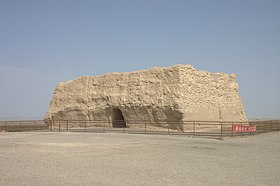Jade Gate
| Yumen Pass | |
|---|---|

The ruin of The Small Fangpa Castle at Yumen Pass
|
|
| Location | 80 km NW of Dunhuang, Gansu, China |
| Coordinates | 40°21′12.6″N 93°51′50.5″E / 40.353500°N 93.864028°ECoordinates: 40°21′12.6″N 93°51′50.5″E / 40.353500°N 93.864028°E |
Yumen Pass (simplified Chinese: 玉门关; traditional Chinese: 玉門關; pinyin: Yùmén Guān), or Jade Gate or Pass of the Jade Gate, is the name of a pass of the Great Wall located west of Dunhuang in today's Gansu Province of China. During the Han dynasty (202 BC - 220 AD), this was a pass through which the Silk Road passed, and was the one road connecting Central Asia and China, the former called the Western Regions. Just to the south was the Yangguan pass, which was also an important point on the Silk Road.
Although the Chinese guan is usually translated simply as "pass", its more specific meaning is a "frontier pass" to distinguish it from an ordinary pass through the mountains. Yumen guan 玉門關 and Yang guan 陽關 are derived from: yu 玉 = 'jade' + men 門 = 'gate', 'door'; and yang 陽 = 'sunny side', 'south side of a hill', 'north side of a river,' and guan 關 = ‘frontier-passes’. These were the two most famous passes leading to the north and west from Chinese territory. During the Early Han, "... a defensive line was established from Jiuquan ('Wine Springs') in the Gansu Corridor west to the Jade Gate Pass at its end."
It is not to be confused with the city Yumen (玉門, literally Jade Gate) in Gansu, China. Although both are within the same Jiuquan "prefecture-level city" (a multi-county administrative unit) of Gansu province, Yumen Pass is located some 400 km to the west of its namesake city.
Travellers to 'The Western Regions' (西域, Xiyu) left China through the famous Yumenguan 玉門關, or 'Jade Gate Frontier-post,' named for the many jade caravans that passed through it. The original Jade Gate was erected by Emperor Wudi (Emperor Wu of Han) soon after 121 BCE and its ruins may still be seen about 80 kilometres (50 mi) to the northwest of Dunhuang which was, until the 6th century, the final outpost of Chinese territory for caravans on their long caravan journeys to India, Parthia, and the Roman Empire.
...
Wikipedia

